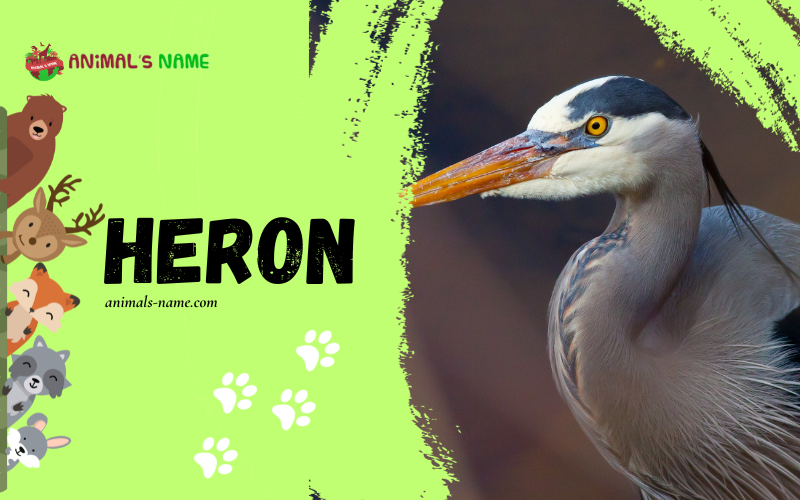Birds are fascinating creatures that can be found in a variety of shapes, sizes, and habitats all over the world. One such intriguing bird is the Heron. Herons are famous for their long legs, long necks, and S-shaped neck curves. They have a rich history and exciting facts and belong to the family Ardeidae under the classification of animals.
The Heron is a large bird typically measuring around 3 to 4 feet in height. They have a wingspan of up to 6 feet, making them excellent flyers. These elegant birds are commonly found near water bodies such as rivers, lakes, and marshes, where they can easily hunt for food. Their habitats vary from freshwater regions to coastal areas, depending on the species.
Herons are classified as birds under the family Ardeidae, which includes other species like egrets and bitterns. They are known for their ability to stand incredibly still for long periods as they patiently wait for their prey, primarily aquatic animals such as fish, frogs, and small reptiles. With their sharp beaks and lightning-fast reflexes, herons are skilled hunters.
Herons are captivating birds that have a significant place in the animal kingdom. With their distinct features, exciting habits, and diverse habitats, they offer a fascinating study for bird enthusiasts and nature lovers. So dive into the world of herons and explore the wonders of these marvellous creatures. And don’t forget, our blog already has an article on over 155 animal names for you to discover!
History of Heron
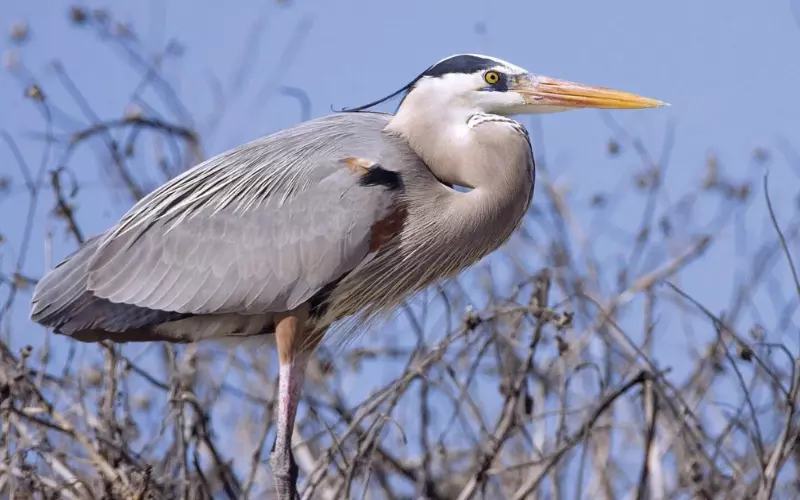
The heron bird has a long and exciting history. This majestic creature has been around for thousands of years and has played a significant role in different cultures and traditions. People have admired the Heron for its graceful appearance and unique characteristics.
Throughout history, herons have been depicted in various forms of art and literature. In ancient Egypt, the Heron was considered a sacred bird and often represented the god of creation. Its image was seen in many hieroglyphics and carvings. In Japan, herons are seen as symbols of good fortune and prosperity. They are believed to bring luck and happiness to those who encounter them.
Aside from cultural symbolism, herons have also made a mark in the scientific world. These birds are known for their exceptional hunting skills, especially when catching fish. Herons can swiftly snatch their prey right out of the water with their long legs and sharp beaks. Scientists have studied and admired these abilities, which have helped us understand the complexities of the natural world.
The heron bird has a rich history, spanning different cultures and scientific studies. Considered sacred in ancient Egypt and symbols of good fortune in Japan, these birds have captivated the attention and imagination of people throughout time. Scientists have admired and studied their unique characteristics and exceptional hunting skills. The Heron serves as a reminder of the fascinating diversity of our world and the wonders of nature.
Importance of Heron
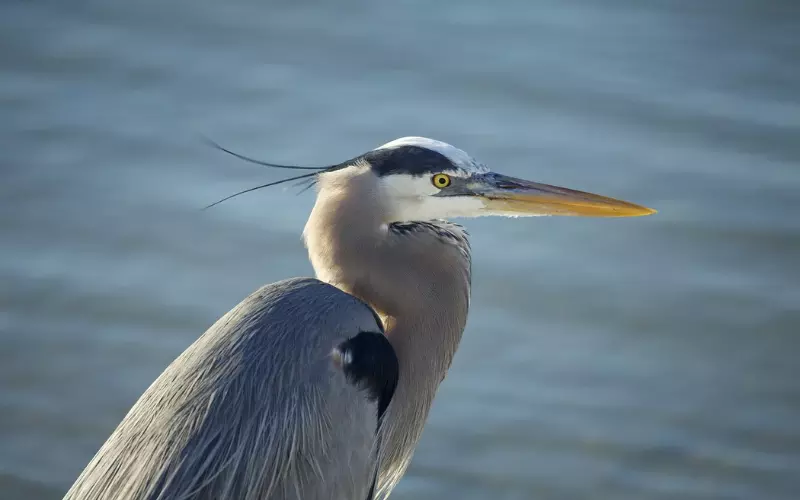
The heron bird is critical in the English language for many reasons. First, it symbolizes patience and wisdom. This means that when someone waits calmly and thinks carefully before making a decision, we say they are as patient as a heron. This reminds us to be calm and thoughtful in our own lives.
Second, the heron bird is known for its graceful movements. It can stand perfectly still in the water for a long time and then suddenly dive to catch a fish with precision. This is why we use the phrase “graceful as a heron” to describe someone who moves elegantly and efficiently. It teaches us to value balance and gracefulness in our actions.
Lastly, stories and poems often mention the heron bird as a symbol of nature and peace. Its presence in literature helps us connect with the beauty of the natural world and reminds us to appreciate the peaceful moments in life. This shows us the importance of respecting nature and finding moments of tranquillity.
The heron bird is vital in English because it represents patience, wisdom, gracefulness, and peace. Its symbolic references help us understand these qualities and encourage us to implement them daily.
Amazing Facts About Heron

1. The heron bird is a tall bird with long legs and a long neck, belonging to the family Ardeidae.
2. Herons are found in every continent except Antarctica, with different species living in diverse habitats such as wetlands, forests, and coastal areas.
3. These birds are excellent hunters and feed on prey, including fish, frogs, insects, and small mammals.
4. The Heron’s large, sharp beak allows it to spear its prey, making it easier to catch and eat.
5. Their long legs enable herons to wade through shallow waters and marshes, hunting for food.
6. Herons have a unique hunting technique called “standing still.” They patiently wait for their prey to come close before swooping and catching it with lightning-fast speed.
7. With a wingspan of up to six feet, herons are skilled fliers and can travel long distances during migration.
8. Herons build their nests high up in trees using sticks and other materials, creating sturdy platforms for their eggs.
9. These birds are known for their beautiful courtship displays, which involve flapping their wings, stretching their necks, and making loud calls to attract a mate.
10. Herons are monogamous and usually mate for life, returning to the same nesting sites year after year.
11. A mother heron can lay 2-7 eggs in one breeding season, and both parents take turns incubating the eggs, which hatch after about three weeks.
12. The chicks are born without feathers and rely on their parents for food, protection, and warmth until they are ready to leave the nest.
13. Herons have a lifespan of about 15-20 years in the wild, although some have been known to live for more than 25 years.
14. These birds have a calm and majestic demeanour, often seen standing gracefully near bodies of water or in trees, awaiting their next meal.
15. While some heron species are thriving, others face threats due to habitat loss, pollution, and disturbance from human activities. Efforts are being made to protect and conserve these fascinating creatures and their environments.
Can we keep Heron as our Pet?

Heron birds are beautiful and fascinating creatures that live in natural habitats like wetlands and swamps. However, it is not suitable to keep herons as pets. These birds need specific conditions and behaviours that make them unsuitable for domestication.
Firstly, heron birds require large open spaces to fly and catch prey. They are skilled hunters and need access to natural resources like fish, frogs, and insects. Captivity limits their ability to hunt and fly freely, significantly affecting their physical and mental well-being. Also, herons have strong migratory instincts and must travel long distances during certain times of the year. I am keeping them as pets, which would restrict their instincts and cause them distress.
Moreover, it is essential to note that some species of heron birds are endangered or even extinct. Due to factors like habitat destruction and pollution, these birds have suffered significant population declines. If a bird species becomes extinct, no more individuals are left. We are responsible for protecting these creatures and their habitats rather than keeping them as pets. Conservation efforts should focus on preserving their natural environments and raising awareness to ensure the survival of these magnificent birds.
Heron birds are unsuitable for pets due to their specific needs and behaviours. Their natural habitats provide the perfect environment for them to thrive, and we must respect their place in the ecosystem. If a bird species becomes extinct, protecting and preserving the remaining species becomes even more critical. We should try to conserve their natural habitats and raise awareness about protecting these unique creatures instead of attempting to keep them as pets.
Size of Heron
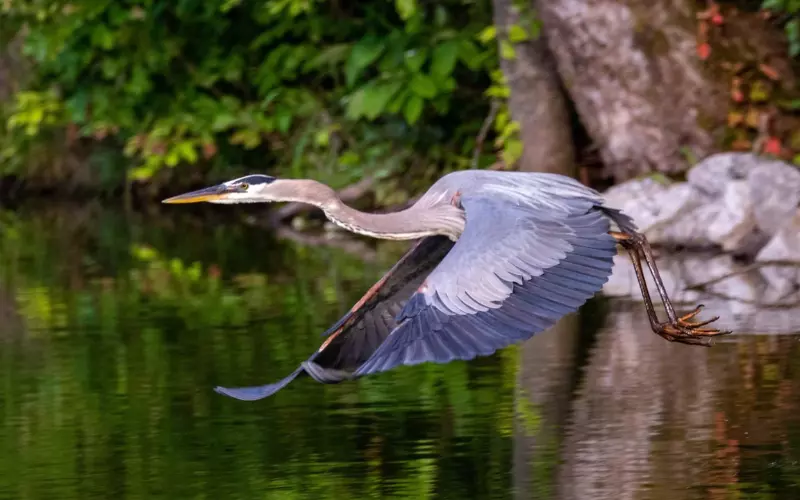
The Heron bird is a majestic creature in many parts of the world. This bird species comes in various sizes, the largest being around 4 feet tall and weighing about 5 pounds. That’s taller than many kids and relatively lightweight for its height!
Heron birds are known for their slender bodies and long legs despite their large size. They have long, sharp beaks that help them catch fish and other small aquatic creatures. These birds are excellent hunters and can stealthily move through the water, patiently waiting for their prey.
The wingspan of a Heron bird is remarkable, spanning up to 6 feet in some cases. This gives them the ability to soar through the sky gracefully. Their long necks can be seen tucked in when flying, forming an elegant curve. It is truly a sight to behold!
The Heron bird is a majestic creature that comes in different sizes. The giant Heron birds can reach up to 4 feet tall, with a wingspan of up to 6 feet. Despite their size, these birds have slender bodies and long legs, allowing them to move through the water to catch their prey stealthily. Whether standing still in the water, flying through the sky, or hunting for food, the Heron bird is a magnificent sight that captivates all who encounter it.
Habitat of Heron
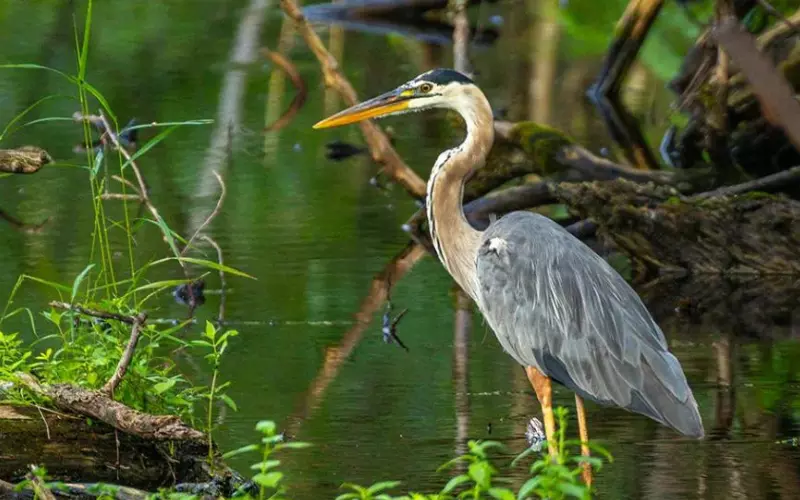
The heron bird is often found near water bodies. Its habitat is usually in wetlands like marshes, swamps, and riversides. These areas are perfect for the Heron, as they provide a plentiful supply of food and safe places to build their nests.
In these wetland habitats, the herons can find many small fish, frogs, insects, and other water-dwelling creatures that make up their diet. The Heron’s long legs and sharp beak help it catch its prey easily. It stalks its prey by standing still in the water or slowly walking, waiting for the perfect moment to strike.
The Heron also requires tall trees or vegetation nearby to build its nests. These nests are often large and sturdy, made of sticks or reeds, and placed high up in the trees to keep the eggs and chicks safe from predators. The Heron’s habitat must provide the proper water, food, and shelter balance to support their population.
Overall, the heron bird needs a habitat with ample water supply, such as wetlands and nearby vegetation for nesting. It relies on these habitats to find food, build nests, and raise its young. By conserving wetlands and maintaining the cleanliness of water bodies, we can help ensure a healthy habitat for the Herons and enable them to thrive for generations to come.
Evolution of Heron
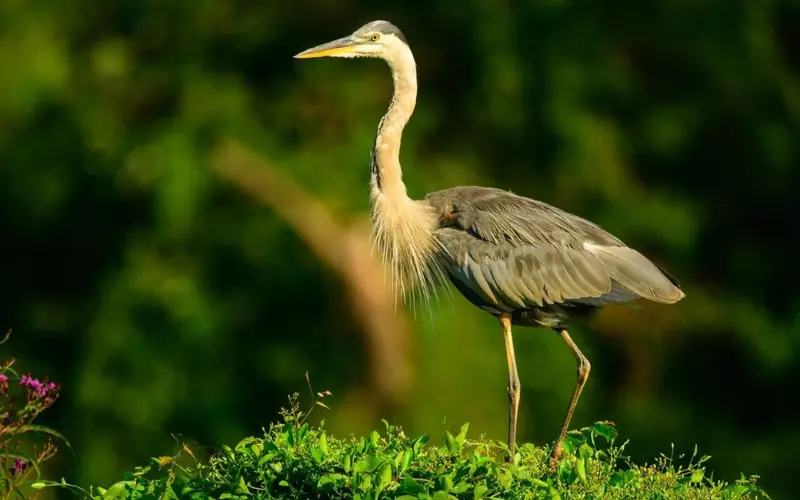
The Heron bird has a long and fascinating history of evolution. Millions of years ago, its ancestors were small, flying dinosaurs. Over time, these dinosaurs gradually changed and adapted to their surroundings, eventually becoming the graceful Heron we know today.
As the Earth’s climate and habitats shifted, some dinosaurs adapted to living near water. These early water-dwelling dinosaurs developed long legs and necks, which allowed them to wade through shallow waters and catch fish more easily. This adaptation was vital for their survival and became a defining characteristic of Heron birds.
As time went on, the Heron’s beak also evolved. At first, it was short and stubby, but as the bird’s diet consisted primarily of fish, it grew longer and thinner. This shape helped the Heron precisely capture fish, making it a skilled hunter.
Another significant change in the Heron’s evolution was the development of its wings. Instead of being used for flight, the Heron’s wings became more practical for balance and stability while wading in the water. The bird’s wingspan also increased, enhancing its ability to glide smoothly across bodies of water.
The Heron bird has come a long way from its dinosaur ancestors. Through millions of years of evolution, it has adapted to its surroundings and developed unique characteristics that allow it to thrive. Its long legs, slender beak, and specialized wing design have made it a master of hunting in water habitats. The Heron’s evolution is a testament to the incredible ability of living creatures to adapt and survive in ever-changing environments.
Classification of Heron
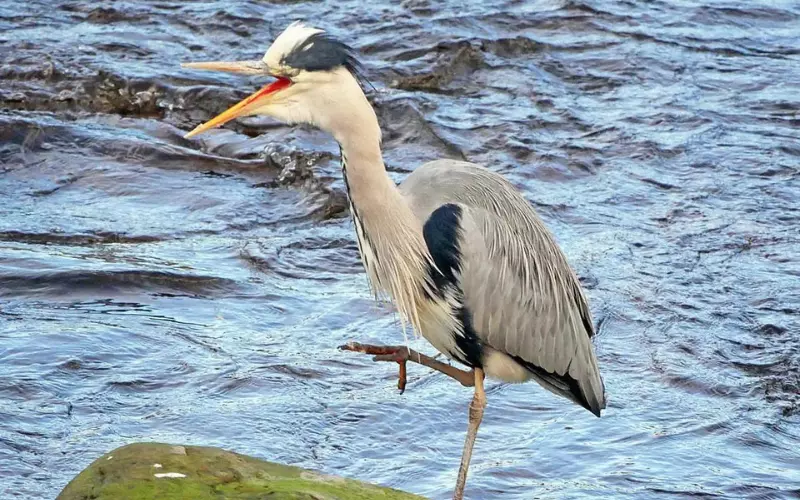
The Heron bird belongs to the family Ardeidae, a group of medium to large-sized birds. Herons are found all around the world, except for Antarctica. They are known for their long legs, long necks, and dagger-like bills.
There are different species of Heron birds, including the Great Blue Heron, the Black-crowned Night Heron, and the Grey Heron, among others. Each species has distinctive features and characteristics. For example, the Great Blue Heron is North America’s largest, with a blue-grey plumage with a white face and crown. On the other hand, the Black-crowned Night Heron has a shorter neck and legs and is more active during the night.
Heron birds can be classified into different groups based on habitat and behaviour. There are freshwater Herons that live near rivers, lakes, and wetlands, and there are also coastal Herons that reside near saltwater environments such as estuaries, marshes, and beaches. Some Heron species are migratory, meaning they travel long distances during specific seasons, while others are non-migratory and stay in the same area year-round.
Heron birds belong to the family Ardeidae and are known for their long legs, long necks, and dagger-like bills. They come in various species, each with its unique characteristics. Herons can be found in different habitats, such as freshwater or coastal areas, and they may migrate or stay in the same place throughout the year. These graceful and majestic birds are a delight to observe in their natural surroundings.
Different Types of Heron
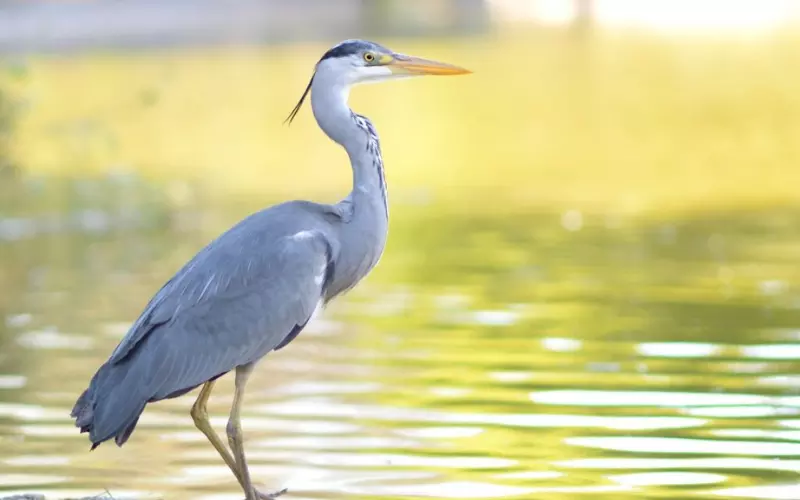
1. Great Blue Heron: The Great Blue Heron is the largest in North America. It has a long, S-shaped neck and a tall body, which helps it catch fish from rivers and lakes. This Heron has a unique blue-grey plumage with a black stripe over its eye. It can stand still for long periods, waiting patiently for prey to approach. Great Blue Herons build large nests made of sticks in trees near water.
2. Green Heron: The Green Heron is a small heron with a distinctive greenish-black plumage on its back. It is mainly found near freshwater habitats like ponds, marshes, and streams. This Heron is an excellent hunter and uses a clever technique to attract fistechnique h. It drops small objects or insects onto the water’s surface, luring the fish to come closer. Green Herons also build nests above the water, often using structures like fallen branches.
3. Black-crowned Night Heron: The Black-crowned Night Heron is a medium-sized heron known for its black cap on its head. As its name suggests, this Heron is well adapted to hunting during the night. It feeds on prey like fish, frogs, insects, and crustaceans. Black-crowned Night Herons nest in trees, often in colonies called “rookeries” near wetlands. Their unique red eyes allow them to see well in the dark.
4. Snowy Egret: The Snowy Egret is a small white heron with elegant long plumes on its back during the breeding season. It can be found in freshwater and coastal areas near marshes or ponds. Snowy Egrets use their bright yellow feet to stir up prey like fish, frogs, and insects in the water. Unlike other herons, they actively chase after their game instead of patiently waiting. This Heron was once nearly hunted to extinction for its beautiful plumes.
5. Little Blue Heron: The Little Blue Heron is medium-sized with a bluish-grey body and a purplish head during the breeding season. It is often seen standing motionless at the water’s edge, waiting to strike at fish or other small aquatic animals. This Heron is known for changing colour from white to bluish-grey as it matures. It nests in trees near water, building platforms made of twigs. The Little Blue Heron is commonly found in coastal wetlands and along rivers.
6. Tricolored Heron: The Tricolored Heron is a medium-sized heron characterized by its blue-grey body, white stomach, and reddish-brown neck. It wades in shallow water and uses a fast stabbing motion to catch fish and other small creatures. This Heron often nests in colonies with other heron species and builds its nest using sticks and leaves. You can find Tricolored Herons in coastal marshes, swamps, and mangroves. During the breeding season, they have long white feathers on their necks.
7. Cattle Egret: The Cattle Egret is a small heron with a white body and a yellow bill. It has a unique habit of following large mammals like cows or buffaldisturbed by these animals’ movements by movements of these animals. They nest in colonies on trees, building flat platforms made of twigs. Originally from Africa, the Cattle Egret has spread to many other countries.
8. Yellow-crowned Night Heron: The Yellow-crowned Night Heron is a medium-sized heron with a distinctive yellow crown. It hunts solitary at night, looking for fish, crustaceans, insects, and small reptiles. This heron nests in trees near wetlands and can also build its nests in shrubs or mangroves. Its beautiful plumage includes greyish-brown feathers and yellowish eyes. The Yellow-crowned Night Heron is often seen along coastal regions and estuaries.
9. Black Heron: The Black Heron, also known as the “umbrella bird,” is a medium-sized heron with black plumage. It stands upright in shallow water, spreading its wings above its head to create a large shadow. This shadow attracts fish towards it, making them easier to catch. Black Herons breed in colonies and are known for their synchronized courtship displays. They can be found in wetlands and swamps across Africa.
10. Goliath Heron: The Goliath Heron is the world’s largest Heron, reaching a height of up to 5 feet. It has a grey body, a white head, and a black stripe running down its neck. This Heron is a patient fisherman, often standing still for long periods before striking. Goliath Herons nest in trees near rivers or lakes, and their nests are large structures made of sticks. They mainly live in Sub-Saharan Africa and are endangered due to habitat destruction and hunting.
Geographical Presence of Heron

The Heron bird is commonly found in regions all around the world. This beautiful creature can be seen in various habitats, including wetlands, marshes, and coastal areas. In North America, Herons can be found in places like Florida and other southern states, where the climate is warm and there is abundant water. Similarly, in Europe, Herons can be spotted in countries like Spain, France, and the United Kingdom, where there are many rivers and lakes.
However, Herons are not commonly found in areas with frigid temperatures. They are not typically seen in regions like the Arctic, where the environment is icy and snowy for most of the year. Likewise, Herons are not usually found in deserts or places with little water. These birds, such as fish, frogs, and insects, rely on wetlands and similar habitats to find food.
The Heron bird can be found in various regions worldwide, especially in warm and wet environments. They are commonly seen in places with ample water sources, such as wetlands, marshes, and coastal areas. However, Herons are not usually found in icy regions, deserts, or areas with limited water. These graceful birds are beautiful and often admired for their elegant appearance and skilled hunting abilities.
Scientific Name of Heron
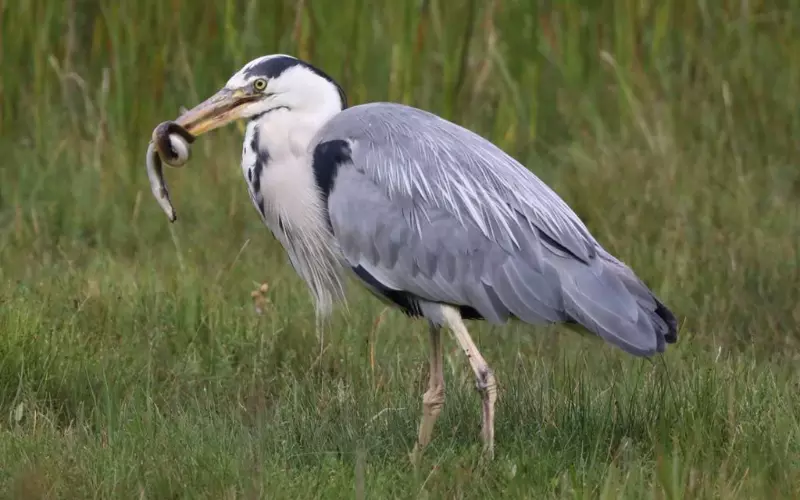
The scientific name of the heron bird is Ardea alba. This beautiful bird is known for its long legs, slender neck, and graceful movements. It belongs to the family Ardeidae, which includes other similar wading birds, such as egrets and bitterns.
The Ardea alba can be found in various habitats worldwide, including wetlands, marshes, and shallow bodies of water. With its tall and slender build, it can easily wade through water in search of its prey, mainly fish, insects, and amphibians.
The heron bird is famous for its distinctive appearance and unique hunting techniques. It patiently waits in shallow water, striking quickly when its prey comes within range. Its long neck allows it to reach into the water or grass effortlessly, providing an advantage during hunting.
The scientific name of the heron bird is Ardea alba. This bird is well-known for its long legs, slender neck, and elegant movements. It can be found in various habitats worldwide and is admired for its distinctive appearance and hunting techniques.
Diet of Heron
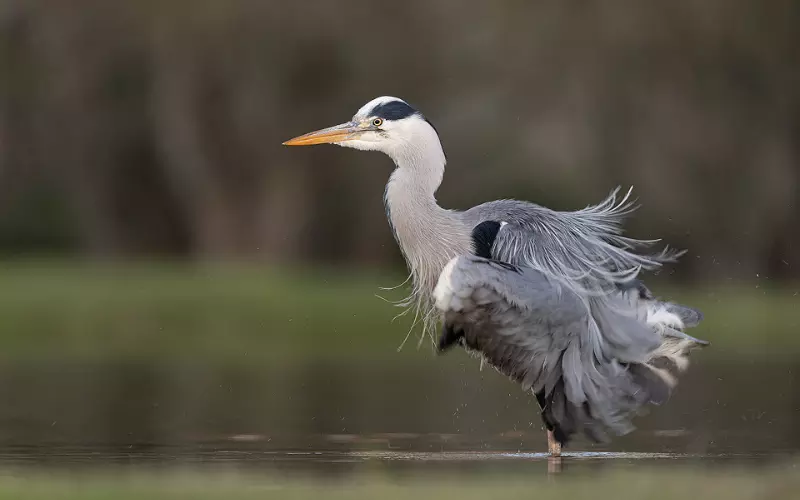
The diet of a Heron bird consists mainly of small fish. These birds are excellent hunters and can catch fish in many different ways. One standard method is standing still in shallow water and waiting patiently for a fish to swim by. Then, with a quick and precise movement, the Heron will snatch the fish out of the water with its long, sharp beak. They can also hunt by strolling in shallow water and using their keen eyes to spot fish swimming below the surface. Once they have caught a fish, Herons will usually swallow it whole, as their long necks and flexible throats allow them to do this easily.
In addition to fish, Herons may also eat other small water creatures like frogs, turtles, and even small birds. They are skilled and robust flyers, allowing them to search for food in many places. Herons are near rivers, lakes, ponds, and coastal areas. They are adaptable birds and can survive in many environments if a good food source is nearby.
Overall, the diet of a Heron bird primarily consists of fish, but they can also eat other small water creatures. These birds are skilled hunters and can catch their food in various ways. With their long beaks, sharp eyes, and solid flying abilities, Herons can find and see their meals in different habitats.
Locomotion of Heron

The Heron bird moves gracefully on land and in the water. When it is on the ground, it walks slowly and carefully. It takes small steps and keeps its long legs straight while walking. This helps it maintain its balance and stability. The Heron bird also uses its wings to help it stay balanced as it walks.
The Heron bird moves even more skillfully when it is in the water. It is an excellent swimmer and can move through the water smoothly. It uses its long legs to paddle and its wings to steer. The Heron bird can also stand still in shallow water, waiting patiently for its prey. Its ability to move quietly and gracefully helps it catch fish and other small animals to eat. The Heron bird’s locomotion is genuinely fascinating to watch!
Social and Sexual Behaviour of Heron
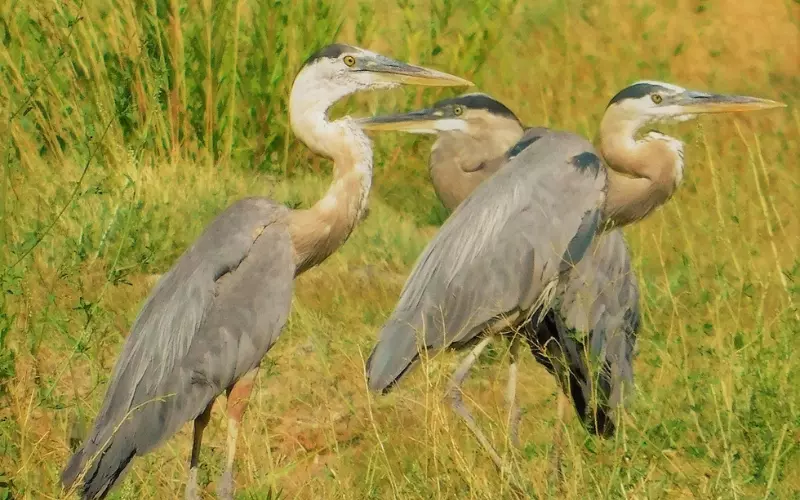
Heron birds have interesting social and sexual behaviours. They often live in colonies or groups, where they interact with each other in various ways. These birds communicate through visual displays and vocalizations. For example, they may use body movements and calls to show aggression, assert dominance, or attract a mate.
When it comes to mating, heron birds have specific rituals. During the breeding season, males work hard to court females and win their affection. They perform elaborate displays, such as flapping their wings, stretching their necks, and making loud calls. These displays aim to impress the females and show their strength and fitness. Once a male successfully catches a female’s attention, they form a pair bond and start building a nest together.
After the pair bond is established, the heron couple goes through a series of courtship behaviours, including mutual preening and offering gifts of sticks or other nest-building materials. This strengthens their bond and prepares them for the breeding season. The female bird then lays her eggs in the nest, and both parents take turns incubating them until they hatch. This shows that heron birds share parenting responsibilities and work together to raise their young.
Heron birds have fascinating social and sexual behaviours. They communicate through visual displays and vocalizations to interact with their colony members, and during mating season, males court females with impressive displays. Once paired, they engage in courtship behaviours and share parenting duties.
Reproduction and Lifecycle of Heron

The heron bird goes through a remarkable life cycle and reproduces fascinatingly. Let’s explore this unique process.
The Heron begins when the female bird lays eggs, usually around 3 to 6. She typically builds her nest high up in trees or on the ground near water bodies. The male and female Heron take turns incubating the eggs, keeping them warm until they are ready to hatch. This can take about 25 to 30 days.
Once the eggs hatch, the heron parents feed their young ones by regurgitating partially digested food into their beaks. The baby herons proliferate and develop feathers within a few weeks. The parents teach them how to catch fish and other small creatures as they grow by watching their hunting techniques. When they are about two months old, the young herons can fly and become independent.
As the young herons mature, they find their territories near their birthplace. They usually form flocks with other herons and breed when they reach the age of around two years old. During the breeding season, the males attract females by performing beautiful courtship displays, such as flying high into the sky or dancing around on the ground. Once a pair is formed, they build a nest together, and the female lays eggs. And so, the life cycle of the Heron begins again, continuing this incredible cycle of life and reproduction.
Threats to Heron
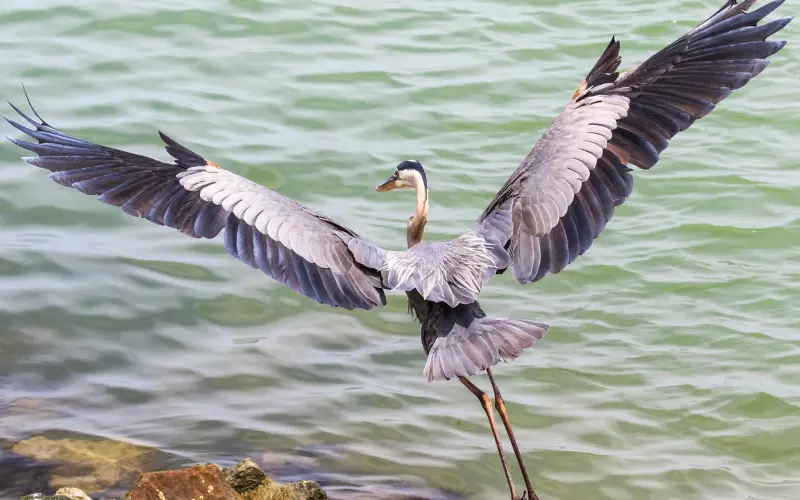
The beautiful Heron bird faces several threats in its natural habitat. These threats can harm the Heron and make it difficult for them to survive. One major threat is habitat loss. As more and more land is used for human activities like farming and construction, the natural homes of the Heron are destroyed. This means fewer places for the Heron to live and find food.
Another threat to the Heron bird is pollution. Pollution can harm the Heron and its environment in many ways. For example, when harmful chemicals and waste are dumped into rivers and lakes, the water becomes contaminated. This pollution can make it hard for the Heron to find fish to eat, as the fish might either die or become sick due to the pollution.
Furthermore, human activities like fishing can also threaten the Heron. Sometimes, when fishermen leave their fishing equipment behind, the Heron can get tangled up in the lines or swallow hooks unknowingly, which can seriously hurt or even kill them. Additionally, some people may hunt Heron birds for their feathers, which are considered valuable. This can significantly reduce the number of Heron birds in an area.
The Heron bird faces various threats like habitat loss, pollution, and hunting. These threats are detrimental to the survival of the Heron and can lead to a decline in their population. Humans must be aware of these threats and take necessary actions to protect the Heron bird and its habitat.
Population of Heron

The population of heron birds is estimated to be around 60 million worldwide. These graceful birds are found in various habitats, such as wetlands, rivers, and coastal areas. They are known for their long necks and sharp beaks, which they use to catch fish and other small creatures to eat.
Unfortunately, the heron bird is now extinct. Over the years, human activities such as hunting and habitat destruction have significantly affected their population. The destruction of their natural habitats, such as wetlands, has led to a decline in their food sources and nesting grounds. Illegal trade and pollution have also contributed to reducing these beautiful birds. As a result, their population gradually decreased until they were completely wiped out.
We must understand the importance of preserving natural habitats and protecting these beautiful creatures from harm. Their extinction serves as a reminder of the negative impact that human actions can have on the environment. By taking responsible steps, we can help prevent the extinction of other species and maintain the delicate balance of our ecosystems.
Conclusion
Herons are fascinating birds found all around the world. These animals belong to the heron family and are known for their long legs, slender bodies, and graceful necks. With a history that dates back millions of years, herons have evolved and adapted to various habitats over time.
One interesting fact about herons is their large size. These birds can grow up to 6 feet tall and have a wingspan of 6 feet or more! They are excellent hunters and feed on small fish, frogs, and insects. Their long beaks help them catch their prey with precision and efficiency.
Habitat-wise, herons are pretty versatile. They can be found near bodies of water such as lakes, rivers, and swamps. Some heron species even migrate to different locations during different seasons, following food availability and suitable nesting areas.
Herons are majestic birds that have a rich history and fascinating characteristics. Their impressive size, adaptable habitats, and skilful hunting techniques make them one of nature’s wonders. Herons will always remain fascinating to study and admire as we continue learning about different animals.
Frequently Asked Questions about Heron (FAQ’s)
What is a heron bird?
A heron bird is a long-legged wading bird found near bodies of water.
What is the average lifespan of a heron bird?
The average lifespan of a heron bird is around 15 years.
How tall can a heron bird grow?
A heron bird can grow as tall as 3 to 4 feet.
What do heron birds eat?
Heron birds primarily eat fish but consume amphibians, reptiles, and small mammals.
Where can heron birds be found?
Heron birds can be found worldwide, except for Antarctica.
How do heron birds catch their prey?
Heron birds usually stand still or slowly wade in the water, then strike their prey with sharp beaks.
Do heron birds migrate?
Yes, some heron birds migrate to warmer areas during winter.
Are Heron birds solitary, or do they live in groups?
Heron birds are typically solitary, although they may form small colonies for breeding purposes.
How do heron birds communicate with each other?
Heron birds communicate through various calls, such as squawks, croaks, and squabbles.
Can heron birds fly?
Heron birds are skilled fliers and can fly long distances.
What is the breeding behaviour of heron birds?
During the breeding season, heron birds build nests in trees and perform elaborate courtship displays.
Do heron birds have any predators?
Yes, heron birds may be preyed upon by larger birds, such as eagles and owls, as well as mammals like raccoons and foxes.
Does the law protect heron birds?
In many countries, heron birds are protected by law due to their declining populations and ecological significance.
Are heron birds considered endangered?
Some species of heron birds are considered endangered or threatened due to habitat loss and pollution.
Can Heron birds adapt to different environments?
Heron birds are adaptable and can be found in various ecosystems, including wetlands, marshes, and coastal areas.

Hey there, I’m Kristen Haudenschild! I’m like a superhero for animals and people.
I work as a Dependable Hard Working Supervisor, which means I help both people and animals grow and learn. I did my school at OdySea Aquarium and Georgia Southern University in Tempe, Arizona. That’s where I learned all about animals, and guess what? I’m fascinated by them!
I even write cool articles about animals. My job history includes being an Animal Trainer and a Marine Mammal Trainer II at OdySea Aquarium. I’ve also been a Senior Animal Care Specialist and an Animal Care Specialist 2.
I love exploring animals and am always ready to help others learn more about them. So, if you ever need info about animals, give me a shout!

